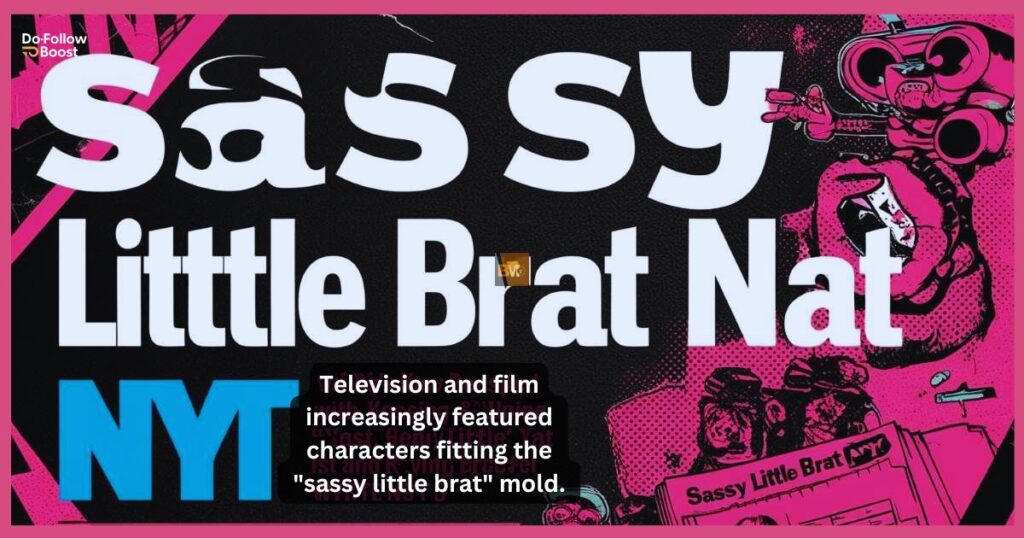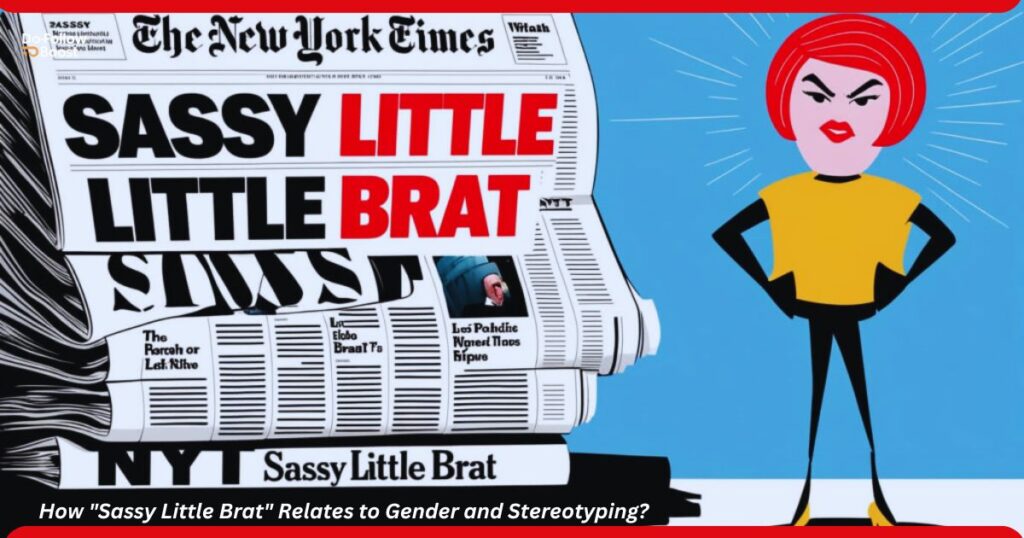The phrase “sassy little brat” has been used in NYT to describe someone with a bold attitude. The phrase “sassy little brat” gained widespread attention after appearing in a New York Times article about modern parenting challenges.
It quickly became a topic of discussion, reflecting changing attitudes towards children’s behavior and assertiveness.
The term’s use in NYT sparked debates about parenting styles, gender stereotypes, and the evolution of language in describing confident, outspoken children.
The Viral Phrase “Sassy Little Brat” in NYT Context
The phrase “sassy little brat” recently gained significant attention after appearing in a New York Times article. This catchy expression quickly caught readers’ eyes and spread across social media platforms. Its use in a prestigious publication like NYT sparked curiosity and debate among readers.
The context of the phrase’s appearance in NYT was a feature story on modern parenting challenges. The article discussed evolving attitudes towards children’s behavior and discipline.
Sassy little brat was used to describe a child exhibiting bold, defiant behavior. This characterization resonated with many parents and educators.
What Does “Sassy Little Brat” Mean?
The term “sassy little brat” combines two distinct descriptors with layered meanings. “Sassy” typically refers to someone who is bold, spirited, and often impertinent. It implies a certain cheekiness or attitude. “Brat” traditionally describes a spoiled or ill-behaved child.
When combined, “sassy little brat” creates a complex image. It suggests a child who is confident and assertive, yet potentially challenging to manage.
The phrase can be seen as both affectionate and mildly critical. Its interpretation often depends on the context and the speaker’s tone.
The Use of “Sassy Little Brat” in NYT Articles

The New York Times first used “sassy little brat” in an article about changing parenting styles. The phrase appeared in a quote from a child psychologist.
It was used to describe children who push boundaries and assert independence. The psychologist discussed the challenges of nurturing confidence while setting limits.
Following this initial usage, the phrase appeared in subsequent NYT pieces. It was referenced in articles about child development and popular culture.
The term became a shorthand for discussing strong-willed children. NYT writers used it to explore generational shifts in behavior expectations.
Cultural Impact of the Phrase “Sassy Little Brat”
The phrase “sassy little brat” quickly entered broader cultural discourse. It became a popular hashtag on social media platforms. Parents used it to share stories of their children’s bold behaviors. The term sparked discussions about child-rearing philosophies and generational differences.
Memes and viral videos featuring “sassy little brats” proliferated online. These often showcased children confidently expressing themselves or challenging authority.
The phrase became associated with a new archetype of childhood. It represented a shift towards valuing assertiveness and individuality in children.
NYT’s Take on Modern Parenting and Child Behavior
NYT coverage explored the complexities of raising “sassy little brats”. Articles discussed the balance between encouraging confidence and setting boundaries. Experts weighed in on the pros and cons of permissive parenting styles. The newspaper presented diverse perspectives on managing strong-willed children.
Parenting columns in NYT addressed strategies for channeling “sassy” energy. They offered advice on nurturing assertiveness without fostering disrespect. The coverage reflected changing societal attitudes towards child behavior. It acknowledged the challenges parents face in today’s environment.
Read This Blog: Exploring Sankaka Complex: Your Gateway to Anime and Manga Culture
Pop Culture and the “Sassy Little Brat” Persona

Television and film increasingly featured characters fitting the “sassy little brat” mold. These portrayals often showed precocious children outsmarting adults. Such characters became popular in family comedies and dramas. They reflected and reinforced the cultural fascination with bold, outspoken kids.
NYT entertainment reviews noted this trend in pop culture. Critics analyzed how these characters resonated with audiences.
They discussed the appeal of seeing children challenge traditional power dynamics. The “sassy little brat” became a recognizable trope in media.
Public Reactions: How Readers Respond to “Sassy Little Brat”
NYT readers had varied reactions to the “sassy little brat” phenomenon. Comment sections filled with personal anecdotes and opinions. Some praised the celebration of children’s confidence and individuality. Others expressed concern about promoting disrespectful or entitled behavior.
Debates emerged about the long-term effects of encouraging “sassiness”. Readers shared experiences of parenting strong-willed children. Many discussed the challenges of navigating modern social expectations. The phrase sparked conversations about evolving family dynamics.
The Evolution of Attitude-Driven Phrases in Modern Language
Linguists noted how “sassy little brat” reflected changing language norms. The phrase exemplified the trend towards more casual, expressive terms. It showed how attitudes towards behavior shape vocabulary. Language experts traced the evolution of similar phrases.
NYT articles explored the history of child-related terminology. They examined how words like “sassy” gained positive connotations.
The coverage highlighted the role of media in popularizing new expressions. It showed how language adapts to shifting cultural values.
Read This Blog: Unveiling Andy Warhella: The Mystery Behind a Digital Art Icon
How “Sassy Little Brat” Relates to Gender and Stereotyping?

Discussions arose about gender biases in applying the term. Critics noted that “sassy little brat” was often used for girls. They argued this reinforced harmful stereotypes about female behavior. NYT opinion pieces explored the gendered aspects of the phrase.
Articles examined how society perceives assertiveness differently in boys and girls. They discussed the potential impact on children’s self-image. Experts weighed in on promoting gender-neutral language. The debate highlighted ongoing issues of equality in child-rearing.
Frequently Asked Questions
What does the phrase “sassy little brat” mean?
It describes a child who is bold, confident, and sometimes challenging. The term combines “sassy” (spirited, cheeky) with “brat” (ill-behaved child). It can be affectionate or mildly critical, depending on context.
Is the phrase “sassy little brat” used negatively?
The phrase can be both positive and negative. Some use it admiringly to describe confident children. Others use it to criticize perceived misbehavior. Its interpretation often depends on the speaker’s tone and context.
Why is the phrase “sassy little brat” connected to NYT?
The New York Times used the phrase in articles about modern parenting. It sparked discussions about child behavior and discipline. The term gained wider attention after appearing in NYT stories.
Does the phrase “sassy little brat” reinforce gender stereotypes?
Some argue it’s more often applied to girls, potentially reinforcing stereotypes. Critics say it can promote different behavioral expectations based on gender. Others view it as a gender-neutral term for confident children.
How is “sassy little brat” portrayed in media?
Pop culture often depicts “sassy little brats” as clever, outspoken characters. They frequently appear in family comedies and dramas. These portrayals usually show children challenging adult authority humorously.
Conclusion
The phrase “sassy little brat” gained significant attention through its use in New York Times articles. It sparked discussions about modern parenting, child behavior, and cultural attitudes. The term’s popularity reflects changing views on childhood assertiveness and independence. Its usage in NYT and subsequent spread across media platforms highlighted evolving societal norms.
The debate surrounding “sassy little brat” touches on various important topics. It raises questions about gender stereotypes, parenting styles, and language evolution. The phrase’s impact demonstrates the power of media in shaping cultural discourse. As attitudes continue to shift, such terms provide insight into our changing perceptions of childhood and behavior.

Amelia is a skilled SEO expert with a strong focus on content writing, keyword research, and web development. With a dedication to delivering results, she helps businesses optimize their online presence and drive organic growth.
Her expertise ensures that clients stay ahead in the ever-evolving digital landscape












